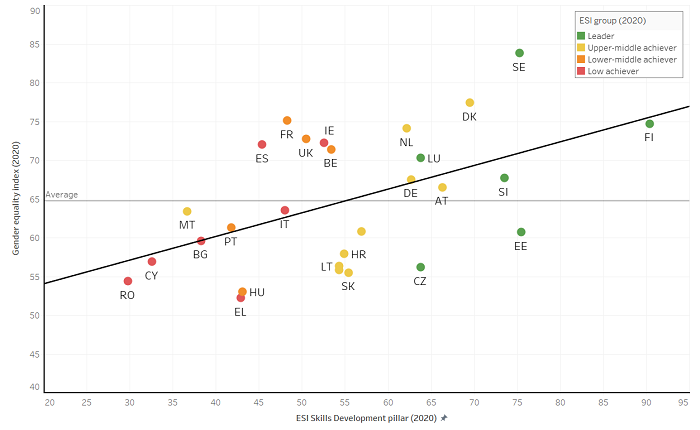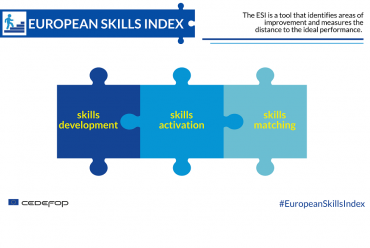Gender balance in EU countries seems to be linked to well-functioning skills systems, according to a comparative analysis of Cedefop’s European skills index (ESI) and the Gender equality index of the European Institute for Gender Equality (EIGE).
Solid national skills systems are critical for fair and well-functioning labour markets – one of the main goals of the European pillar of social rights. The ESI, a skill monitoring tool developed in support of the Pillar’s implementation, also helps EU Member States understand complex socioeconomic phenomena.
A positive link between the development of a strong skills system and gender equality was first established by Cedefop in early 2020. This relationship was re-examined following the release of the updated versions of the ESI in May by Cedefop and the Gender equality index in October by EIGE. The question Cedefop sought to answer was whether progress towards more equal societies is associated with advancements towards better-functioning skills systems, with a focus on skills development.
Cedefop expert for developing the ESI, Ilias Livanos, points out that ‘the development of a solid skills system has socioeconomic returns that are often neglected. Our research shows that gender equality goes through the development of a fair and inclusive skills system, the outputs of which are also channelled into the structures of society’.
The data analysed suggest that a well-functioning skills system is indeed one of the prerequisites for achieving better gender equality, indicating that the first two principles of the Pillar (i.e. skills development and gender equality) go hand in hand.
Figure 1 plots the ESI skills development pillar against the Gender equality index. Countries with well-functioning mechanisms for developing people’s skills through education and learning are in general associated with higher levels of gender equality. Examples include Sweden, Finland and Denmark, countries where the institutional structure aims at simplifying the combination of parenting, vocational education and training and work, stimulating women not only to participate in the labour market actively but to also receive continuous training. In contrast, countries lagging behind in terms of skills development (e.g. Greece, Romania, Cyprus and Bulgaria) also appear to be below-average performers in gender equality. These are in most cases countries with a low overall performance in their skills systems (i.e. the ESI low achievers). Finally, the existence of countries roughly tied in terms of skills development but with different levels of gender equality (e.g. Estonia and Sweden) or the opposite – with similar equality levels but dissimilar performance in skills development (e.g. Finland and France) – suggests that the causal relationship between better skills development and more gender equality runs in both directions.
Figure 1: ESI skills development pillar and EIGE’s Gender equality index

A more direct evaluation of the discriminatory nature in a country’s institutions is provided by the OECD’s Social institutions and gender index (SIGI). It measures the existence of discriminatory formal and informal laws, attitudes and practices that restrict women’s access to rights, justice and empowerment opportunities. A comparison between the latest version of the SIGI (released in 2019) and the 2020 ESI skills development pillar for the EU-27 (minus Luxemburg, which was not covered by the SIGI) in Figure 2, reveals a clear negative relationship between the two indices. Although this does not necessarily point to causation, it means that more adequate skills development in a country is essentially associated with social and economic institutions that are less discriminatory against women.
Figure 2: ESI skills development pillar and the OECD’s Social institutions and gender index

The comparison also shows that countries lagging behind in skills development can have institutions with widely differing levels of discrimination. This extends to countries with weaker skills systems (the ESI low achievers) as well. For example, Greece and Spain are roughly tied in terms of skills development but Greece has almost twice the discrimination levels of Spain. Still, as skills development (as well as the skills systems in general) improves, both the discrimination levels as well as their dispersion across countries appears to drop, suggesting that the causal link from well-functioning skills development mechanisms towards more gender equality is particularly strong. Translated into real-life examples, this means that women who are able to develop their skills adequately, secure higher wages in the labour market, as well as seats of power, and eventually reduce gender gaps in various aspects of everyday life.



